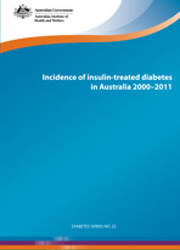Summary
Diabetes results in a large health and economic burden for individuals, families and communities. There were around 53,500 people in Australia who began using insulin to treat their diabetes in 2011― 68% had type 2 diabetes, 12% had gestational diabetes, 4% had type 1 diabetes and 1% had other forms of diabetes requiring insulin (diabetes type was unknown for another 15%).
This report uses data from the National (insulin-treated) Diabetes Register to examine the incidence of insulin-treated diabetes in Australia for the three main types of diabetes.
Type 1 diabetes
- In 2011, there were 2,367 new cases of type 1 diabetes in Australia, equating to 11 new cases per 100,000 population. This rate has remained stable over the last decade, with between 10 and 12 new cases per 100,000 population per year.
- Half of all new cases of type 1 diabetes were among people aged 18 or under. Rates of type 1 diabetes peaked in the 10-14 age group at 32 per 100,000 population: a rate 5 times as high as for those aged 40-44.
- The incidence of type 1 diabetes was higher in males than in females-13 in every 100,000 males compared with 8 per 100,000 females.
- The incidence of type 1 diabetes did not vary considerably across the states and territories (10-13 per 100,000), except in the Northern Territory where the rate was considerably lower at 8 cases per 100,000. Rates of type 1 diabetes also did not vary by socioeconomic status.
- The incidence of type 1 diabetes was lower in Remote and very remote areas (compared with other areas in Australia) and was lower for Indigenous Australians compared with non-Indigenous Australians.
Insulin-treated type 2 diabetes
- In 2011, 36,263 people began using insulin to treat their type 2 diabetes, equating to 163 people per 100,000 population.
- The incidence of insulin use for type 2 diabetes increased rapidly with age, with rates increasing five-fold between ages 40-44 and 70-74 (100 compared with 550 per 100,000 population, respectively).
- Rates were higher among males than females at 185 compared with 140 per 100,000 population, respectively.
- Rates of insulin-treated type 2 diabetes were twice as high for those living in the lowest socioeconomic status (SES) areas compared with the highest SES areas.
Insulin-treated gestational diabetes
- There were 6,362 women aged 15-49 who began using insulin to treat gestational diabetes in 2011, equating to 117 per 100,000 women in this age group in Australia.
- Rates of insulin-treated gestational diabetes varied across states and territories and by socioeconomic and geographical areas.



